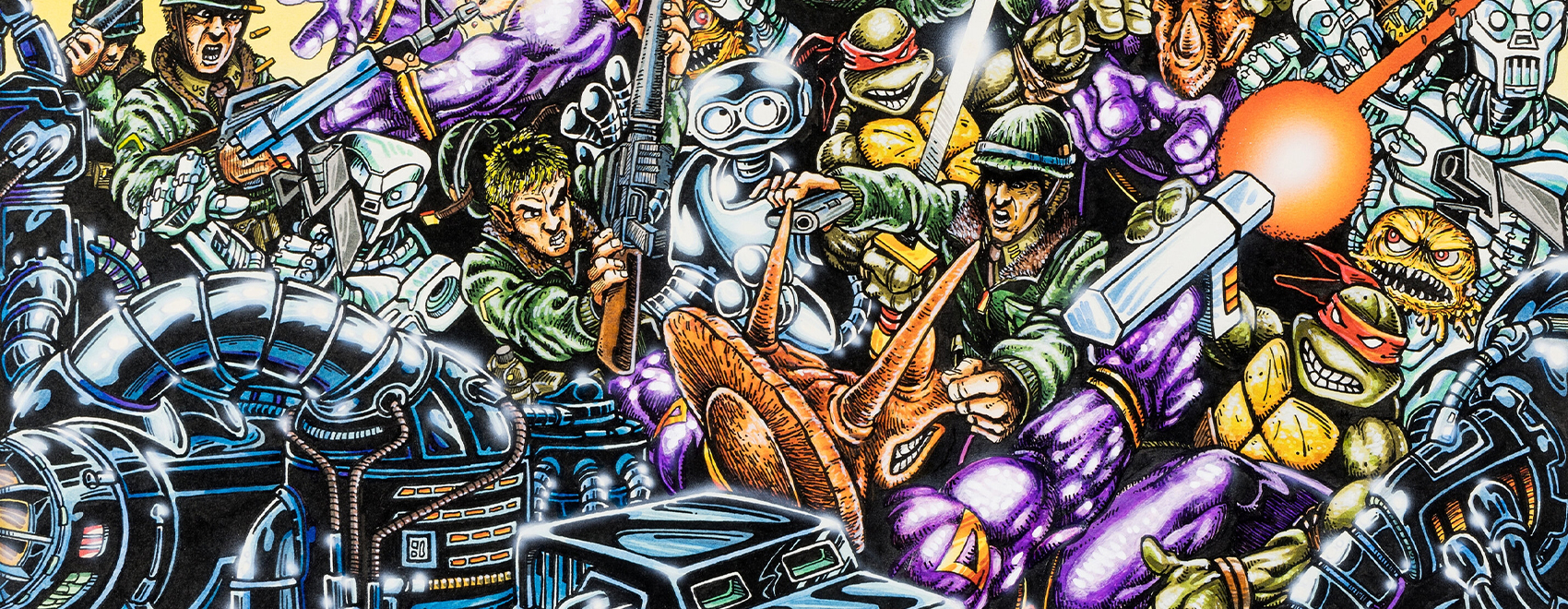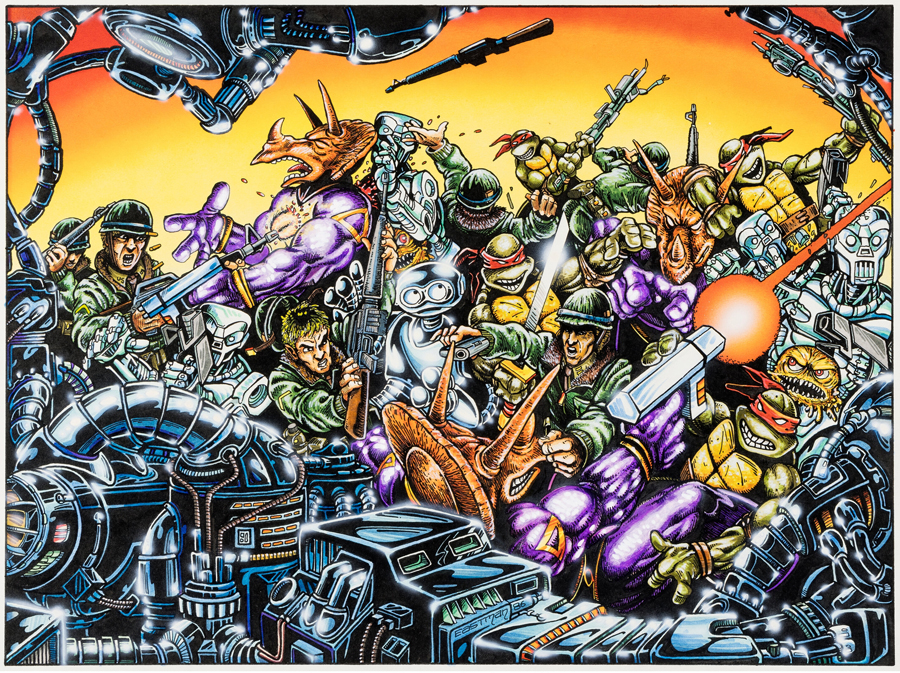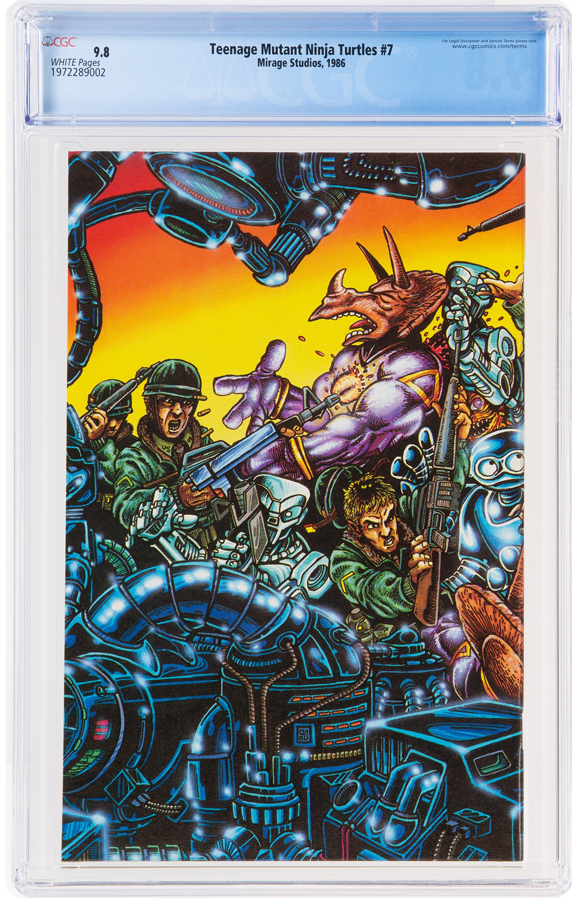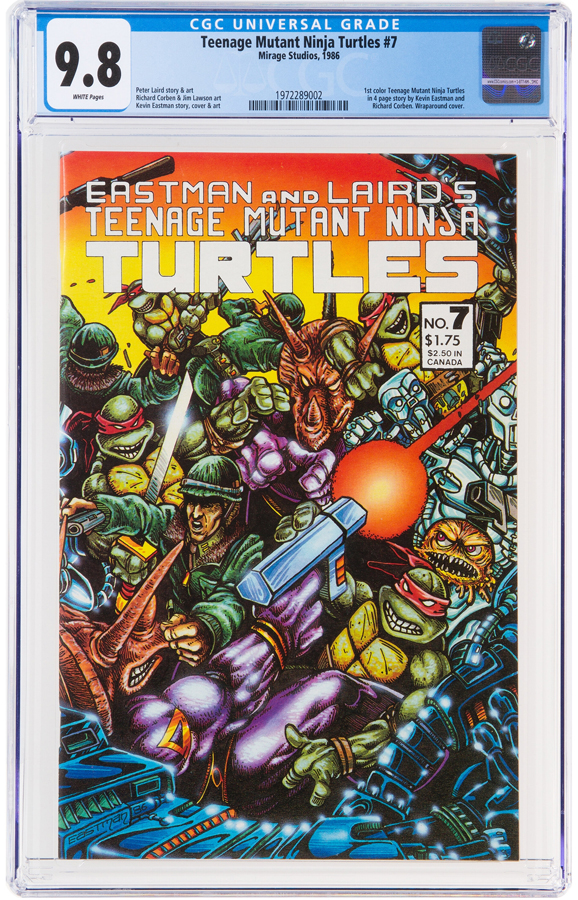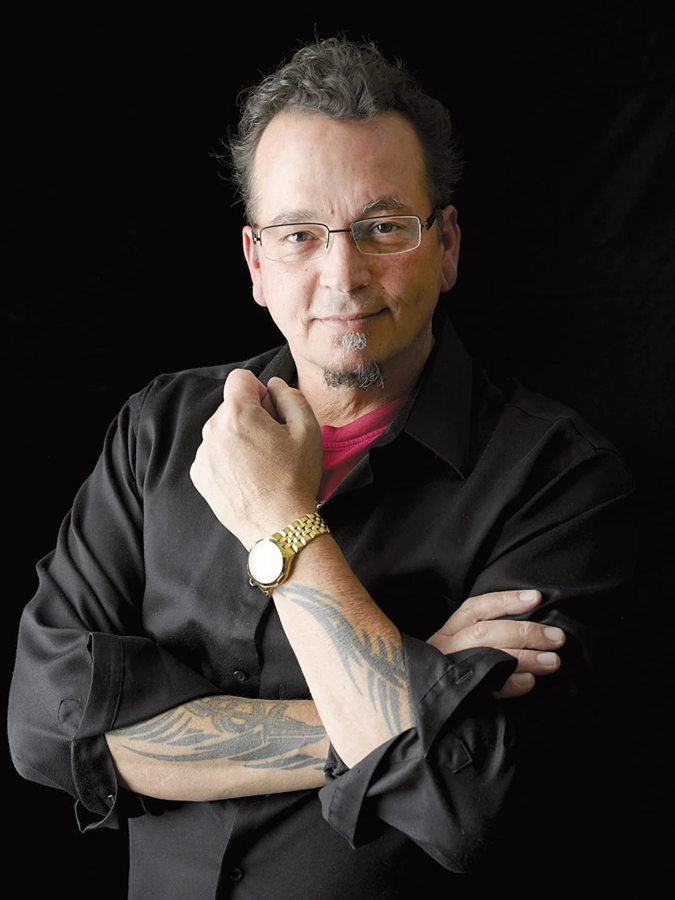‘FULL-ON MAYHEM’ IS HOW KEVIN EASTMAN DESCRIBES HIS 1986 CREATION
By Robert Wilonsky
Kevin Eastman, co-creator of Teenage Mutant Ninja Turtles with Peter Laird, welcomed readers to their seventh issue with a long note that began: “We’ve tried very hard to make this issue as special as possible.” That was evident before anyone even cracked the issue, as it boasted a radiant cover featuring the book’s namesake stars – Raphael, Michelangelo, Leonardo and Donatello – smack in the center of an all-guns-a-blazing battle surrounded by Triceratons, Utroms, a Fugitoid and last-stand soldiers trying their best to do their very worst to each other. The scene is chaotic, brutal and even a little delightful – because, let’s remember, these are bandanaed turtles, after all, just a year away from storming toy store shelves and Saturday morning TV.
Kevin Eastman’s cover art for ‘Teenage Mutant Ninja Turtles’ No. 7 is available in Heritage’s April 3-6 Comics & Comic Art Signature® Auction.
In that issue’s Turtle Tracks, Eastman wrote that Teenage Mutant Ninja Turtles No. 7 was intended to “completely wrap up” an ongoing saga – all the secrets of the ooze had been spilled! – while pointing toward “some really wild single issue adventures” to come. He mentioned, too, that this issue was particularly meaningful to him because it featured the series’ first full-color story, which had been inked by fantasist Richard Corben, whose work could charm and disturb in equal measure. “Incredible or what?” Eastman wrote. He’s no less excited today than he was upon the issue’s release in 1986.
“Jack Kirby inspired me to write comics, but Richard Corben was one of my heroes when it came to independent publishing and creativity,” Eastman tells Intelligent Collector. “He was the first one who showed me what comics could be aside from Comics Code of America-approved stories. He was an incredible man I looked up to in every possible way, one of my heroes and biggest inspirations.”
That issue’s spectacular cover, which heads to auction for the first time as one of the myriad centerpieces of Heritage’s April 3-6 Comics & Comic Art Signature® Auction, serves as homage to Kirby and Corben – while cementing Eastman’s legacy with Laird as a storyteller who laid a yard’s worth of Silly Putty over pop culture then stretched it a mile long. Eastman recently took time out of his busy schedule – he was late finishing a cover – to discuss Teenage Mutant Ninja Turtles No. 7, the issue’s cover and what it all meant in those moments before every kid in America took a dip in the ooze.
The wraparound cover for ‘Teenage Mutant Ninja Turtles’ No. 7 as it appeared on the front and back of the 1986 issue. This copy of the book, graded CGC NM/MT 9.8, sold in a December 2020 Heritage auction.
Robert Wilonsky: From the very beginning, you spoke of Jack Kirby’s influence, but Richard Corben, your collaborator on the four-page color story inside, always seems more obvious – and your collaboration, inevitable. In Turtle Tracks, you even liken it to an “aspiring young guitarist getting the chance to work with Keith Richards, Jimmy Page or even Springsteen.”
Kevin Eastman: That’s what it was! When I talk about Kirby, besides being one of the greatest creators in the history of comics, he was so innovative in his impressionistic style, way of storytelling and the energy he put into it. Corben wasn’t necessarily a fan of Kirby’s, but he was tapping from the same vein: His stories were way over-the-top. He broke the mold. Things were raw and meaningful and sometimes ugly and violent, and you had this different kind of energy, like when you saw an R-rated movie for the first time. Their approach to storytelling was unapologetic. They just did it, and you either liked it, or you hated it. I loved it.
RW: The word that comes to mind when I think of both men is “visceral.”
KE: Well said. That’s one of the things I picked up from them. They were having more fun creating stories for themselves. Maybe I am reading way too much into it, and Kirby’s work was certainly intended as commercial since he was working for Marvel and DC, but it was more like they were having a good time doing something they enjoyed, telling these kinds of stories, and that’s what resonated. When Peter and I started doing the Turtles, we were so lucky for the underground, self-publishing movement. So when writing these stories, we controlled them and could tell the kinds of stories we wanted to read. We were writing for ourselves.
RW: One thing that’s so striking about the cover is that it’s garish in a way, all those bright colors, but it’s also incredibly raw.
KE: The cover for Issue No. 7 was a full-combination tribute to Kirby and Corben, throwing both into the blender. They would do these incredibly complex scenes using two-page spreads, which Peter and I did early on to set the stage for everything that came after. That’s what I loved about the cover: the full-on mayhem, arms and bodies and shooting and all the things you imagine a battle like that would look like.
I look at it now, and that guy in the back – his eyeball is too big, or his arm is too long. [Laughs] Any criticisms I have are about my own shortcomings as an artist, but the passion is there. It worked as a piece, and I had an absolute blast doing it. That was the fun part. It was a fanboy moment for me.
Eastman is best known for co-creating the characters Raphael, Michelangelo, Leonardo and Donatello, aka the Teenage Mutant Ninja Turtles.
RW: You and Peter essentially shared a workspace, shuffling pages back and forth as you alternated penciling, inking and lettering. What was Peter’s reaction to it?
KE: We were each other’s biggest cheerleaders. When he brought in his sketch for the cover to Issue No. 4, I was like, “Expletive, expletive, wow.” The camaraderie, just waiting to see what the other co-parent of the Turtles came back with, their vision of a scene, that was so much fun. Our approaches were stylistically a bit different, but it was always nice and pleasant and like, wow, you get to see into your best friend’s brain.
RW: The more I look at the cover, the more I see in there. While we’re talking, the name H.R. Giger comes to mind. You were absorbing so much and starting to make it your own.
KE: It’s like someone said, and maybe it was Bob Dylan: Every artist is a thief. And it’s true. Everything Peter and I were consuming as fans of the genre, whether it was shows like Star Trek or movies like Star Wars or Alien. You look at all those things and pull from them as inspirations, the things that give you goosebumps. You take those things that are so freaking cool and roll them into something you can use for your own story – the same inspirations, the same vibes. The Turtles’ origin was inspired by the Fantastic Four and Daredevil, where Marvel probably should have sued us. [Laughs] But it was the pop culture that inspired us worn on our sleeves.
RW: When working on the cover, you imagine it as one thing. But when finished, it becomes real, tangible – a thing to critique rather than a concept to realize. What was it like to see it actually, finally finished?
KE: That’s such an important question because artists are our own worst enemies – critics, anyway. The only thing we have is our imagination, and sometimes we imagine something in our mind’s eye. When you try to put it on paper, what you’ve imagined versus what you’ve created can be vastly different. Sometimes I would finish a piece and say, “This is what I thought I wanted to do.” Sometimes there are happy accidents. And sometimes there are shortcomings because you’re like, “I wanted this to come out like Richard Corben did it,” and then you realize, “I am not Richard Corben.”
A year or two later, you can look back and say, “Well, I didn’t fuck it up too bad.” [Laughs] Sometimes we beat ourselves up a little more than we should. But with this one, I do remember having this great level of satisfaction. Even with the mistakes, it is what it is, and I had a great time doing it.
This interview has been edited and condensed for clarity.
 ROBERT WILONSKY is a contributor at Intelligent Collector.
ROBERT WILONSKY is a contributor at Intelligent Collector.

